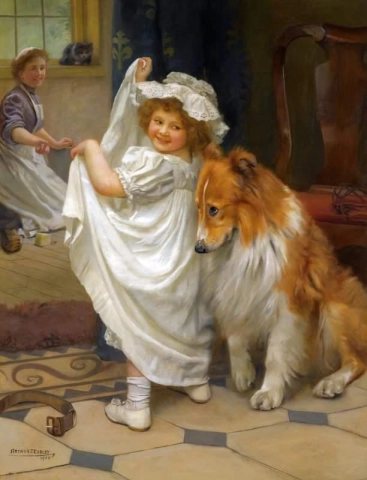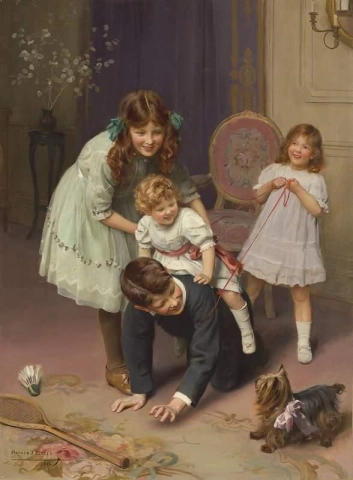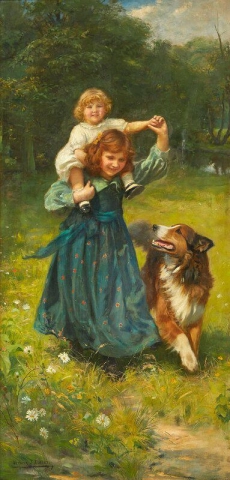

Hand painted reproductions of Arthur Elsley
Arthur Elsley: Master of Romantic Animal and Equestrian Paintings
Arthur Elsley (1860–1952) was a renowned British painter, best known for his romantic depictions of animals, particularly horses, dogs, and pastoral scenes. His work resonated with the Victorian and Edwardian public, capturing the grace and vitality of animals, often set in idyllic landscapes. Elsley’s skill in portraying the intimate bond between humans and animals, coupled with his ability to bring light and life into his compositions, secured his place as one of the leading animal painters of his era.
Early Life and Education
Arthur Elsley was born on 17 May 1860 in London, England. His early life was marked by a deep interest in the natural world, particularly animals. From a young age, he showed an aptitude for drawing and was encouraged by his family to pursue a career in the arts. Elsley’s formal education began at the Royal Academy Schools in London, where he honed his technical skills and deepened his understanding of traditional painting techniques.
During his time at the Royal Academy, Elsley focused on the study of anatomy, both human and animal, which would become an essential component of his work. He developed a fascination with horses and dogs, which would remain central themes in his career. Elsley’s early artistic endeavors were influenced by the academic tradition of British painting, yet he sought to imbue his works with a sense of emotional warmth and narrative engagement.
Artistic Development and Style
Elsley’s early works were influenced by the Victorian Romantic movement, which emphasized the portrayal of subjects imbued with emotional depth and a sense of nostalgia. As a painter, Elsley was particularly adept at creating highly detailed, lifelike representations of animals. His works often featured horses and dogs in serene, countryside settings, conveying a sense of harmony between the creatures and the natural world.
One of Elsley’s defining characteristics as an artist was his remarkable skill in capturing the movement and personality of animals. Whether depicting a playful dog in a field or a majestic horse in motion, Elsley’s attention to anatomical accuracy and dynamic postures set his works apart from those of his contemporaries. His brushwork was fluid, creating a sense of vitality and realism, which helped bring his subjects to life on the canvas.
Elsley was especially renowned for his use of light, often employing soft, glowing tones to enhance the emotional resonance of his scenes. His outdoor scenes, bathed in natural sunlight, evoked a sense of tranquility and nostalgia, reinforcing the connection between animals and their environment. He often depicted scenes of rural life, where animals were central to the pastoral landscape, creating a harmonious balance between the creatures and the surrounding nature.
While his works were detailed and lifelike, they were also imbued with a sense of idealized beauty. Elsley’s romantic portrayal of animals, combined with his ability to evoke a sense of emotional depth, allowed him to appeal to a wide audience. His works spoke to the Victorian public’s deep affinity for the pastoral ideal and their growing appreciation for the beauty of nature and animals.
Themes and Significance
Arthur Elsley’s work primarily focused on animals, particularly horses and dogs, but also included scenes of children interacting with animals, rural life, and idyllic landscapes. These themes resonated with the public during the late 19th and early 20th centuries, as they reflected an idealized, harmonious relationship between humans and the natural world.
His works often depicted the joy of childhood, with children playing with animals in natural settings, reinforcing the theme of innocence and the bond between humans and animals. Many of his pieces feature children with dogs or ponies, highlighting the emotional connection and loyalty between species. His portrayal of animals was both tender and energetic, capturing their personalities and bringing them to life in a way that was relatable to the viewer.
In addition to his animal paintings, Elsley also produced equestrian portraits and hunting scenes, where the grace and power of the horses were central to the composition. His mastery of capturing movement, whether of an animal at rest or in action, was a key feature of his style and helped elevate his work within the broader context of Victorian and Edwardian art.
Elsley’s ability to convey a sense of warmth and emotional engagement through his paintings made him a beloved artist during his lifetime. His works continue to resonate with audiences for their timeless portrayal of the beauty and vitality of animals, as well as their nostalgic evocation of a bygone rural life.
Achievements and Recognition
Elsley’s career flourished during the late 19th and early 20th centuries, and his works were exhibited regularly at the Royal Academy and other prominent galleries. His paintings were popular with both private collectors and public institutions, and his ability to capture the charm of rural life and the emotional connection between humans and animals made him one of the leading animal painters of his time.
Arthur Elsley’s works were frequently reproduced in various forms, including prints, further cementing his popularity. His ability to depict animals with a sense of personality and emotion, combined with his mastery of light and color, made his paintings highly sought after. During his career, Elsley gained recognition as an artist who could capture the spirit of both animals and the human condition in a way that few could match.
In 1914, he was awarded a prestigious commission to paint a large equestrian portrait for the King of Belgium, a significant recognition of his talents. His works were also featured in numerous exhibitions across Britain and Europe, earning him widespread acclaim.
Legacy
Arthur Elsley’s legacy is defined by his extraordinary ability to capture the natural world in all its beauty and vitality. His romantic portrayals of animals and rural life, imbued with emotional depth and charm, remain beloved by collectors and art enthusiasts to this day.
His works are celebrated for their technical brilliance, particularly his ability to depict animals with lifelike accuracy while infusing them with personality and character. Elsley’s romantic idealization of the bond between humans and animals resonated with the public, reflecting an era’s deep connection to the countryside and an appreciation for the simple pleasures of life.
Although modernism eventually overshadowed the academic and Romantic styles, Elsley’s art continues to be cherished for its warmth, innocence, and enduring charm. Today, his paintings are displayed in numerous galleries and private collections, admired for their beauty, technical skill, and emotional depth.
Where to Find Reproductions of Arthur Elsley’s Art
For those interested in acquiring high-quality reproductions of Arthur Elsley’s art, prints of his renowned animal and equestrian paintings are available. These reproductions capture the warmth and vitality of his subjects, allowing viewers to enjoy the beauty of his works in their own homes.
Imagine owning an original-style painting by one of the greatest artists in history. At POD, we offer you the chance to make this dream a reality. Each canvas is faithfully reproduced down to the smallest detail, allowing you to experience the beauty of the artist’s vision in your own home.
Our reproductions are crafted by experienced painters using the finest materials and time-honored methods. We are committed to delivering works of exceptional quality that will inspire and bring joy to your family for generations to come.





























